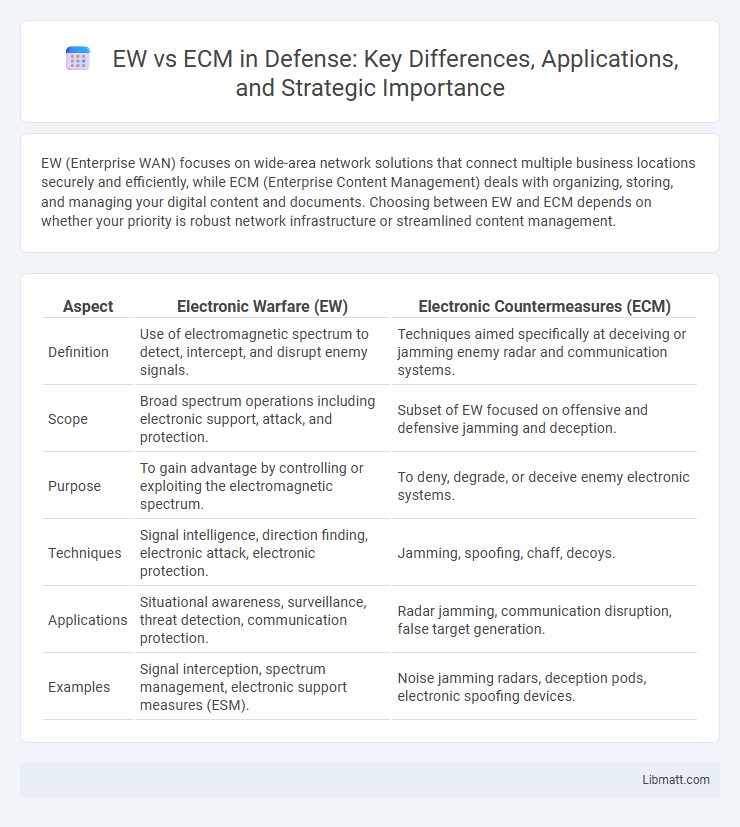EW (Enterprise WAN) focuses on wide-area network solutions that connect multiple business locations securely and efficiently, while ECM (Enterprise Content Management) deals with organizing, storing, and managing your digital content and documents. Choosing between EW and ECM depends on whether your priority is robust network infrastructure or streamlined content management.
Table of Comparison
| Aspect | Electronic Warfare (EW) | Electronic Countermeasures (ECM) |
|---|---|---|
| Definition | Use of electromagnetic spectrum to detect, intercept, and disrupt enemy signals. | Techniques aimed specifically at deceiving or jamming enemy radar and communication systems. |
| Scope | Broad spectrum operations including electronic support, attack, and protection. | Subset of EW focused on offensive and defensive jamming and deception. |
| Purpose | To gain advantage by controlling or exploiting the electromagnetic spectrum. | To deny, degrade, or deceive enemy electronic systems. |
| Techniques | Signal intelligence, direction finding, electronic attack, electronic protection. | Jamming, spoofing, chaff, decoys. |
| Applications | Situational awareness, surveillance, threat detection, communication protection. | Radar jamming, communication disruption, false target generation. |
| Examples | Signal interception, spectrum management, electronic support measures (ESM). | Noise jamming radars, deception pods, electronic spoofing devices. |
Introduction to EW and ECM
Electronic Warfare (EW) involves using electromagnetic energy to detect, deceive, or disrupt enemy electronic systems, enhancing battlefield advantage through tactical spectrum dominance. Electronic Countermeasures (ECM) represent a subset of EW, focused specifically on methods to jam, spoof, or intercept hostile radar and communication signals to protect assets and impair adversary effectiveness. Your understanding of EW and ECM enhances strategic decisions in modern military operations, leveraging technology for superior situational awareness and defense.
Definitions: What are EW and ECM?
Electronic Warfare (EW) refers to the use of electromagnetic spectrum to detect, intercept, or disrupt enemy electronic devices, including radar and communication systems. Electronic Countermeasures (ECM) are a subset of EW specifically designed to deceive or jam the enemy's electronic sensors and communication to protect friendly forces. Your understanding of EW and ECM is crucial for grasping modern military tactics involving electromagnetic spectrum dominance.
Historical Evolution of EW and ECM
Electronic Warfare (EW) originated during World War II with basic radar jamming and interception techniques, evolving into sophisticated methods that integrate cyber and signal intelligence to dominate the electromagnetic spectrum. Electronic Countermeasures (ECM), as a crucial branch of EW, initially focused on disrupting enemy radar and communications but now employ advanced technologies like digital signal processing and artificial intelligence to enhance survivability and mission success. Your understanding of EW and ECM must consider this historical evolution to appreciate their strategic roles in modern military operations.
Key Components of Electronic Warfare (EW)
Electronic Warfare (EW) encompasses three key components: electronic attack (EA), electronic protection (EP), and electronic support (ES), which collectively enable the disruption, defense, and intelligence gathering in the electromagnetic spectrum. Electronic attack employs jamming and deception techniques to impair enemy radar and communications, while electronic protection safeguards friendly systems from interference and detection. Electronic support involves signal interception and analysis for threat identification, enhancing situational awareness and decision-making in contested environments.
Core Functions of Electronic Countermeasures (ECM)
Electronic Countermeasures (ECM) focus on disrupting or deceiving enemy radar, communication, and missile guidance systems through jamming, deception, and stealth technologies. Core functions include radar jamming by emitting false signals, communication denial via signal interception and interference, and missile deception using decoys or electronic spoofing techniques. Your defense systems can significantly enhance survivability and mission success with effective ECM implementation.
EW vs ECM: Main Differences
Electronic Warfare (EW) encompasses a broad range of strategies aimed at controlling the electromagnetic spectrum to disrupt enemy operations. Electronic Countermeasures (ECM) specifically refer to techniques within EW designed to deceive, jam, or neutralize adversary radar and communication systems. Understanding the distinction between EW and ECM enhances your ability to implement effective defense and offensive tactics in modern military operations.
Applications of EW and ECM in Modern Warfare
Electronic Warfare (EW) employs technologies like jamming, deception, and electronic surveillance to disrupt or deny enemy use of the electromagnetic spectrum, enhancing battlefield situational awareness and communication security. Electronic Countermeasures (ECM) specifically target enemy radar and communication systems by deploying tactics such as signal jamming, spoofing, and radar confusion to degrade their operational effectiveness. Both EW and ECM are critical for modern military operations, supporting air defense suppression, missile guidance disruption, and secure tactical communication networks in complex combat environments.
Technologies Used in EW and ECM Systems
Electronic Warfare (EW) utilizes technologies such as radar jamming, signal interception, and electronic countermeasures to disrupt or deceive enemy communication and radar systems. Electronic Countermeasures (ECM) specifically employ advanced techniques like noise jamming, deception jamming, and electronic decoys to neutralize or confuse hostile radar and missile guidance. Both EW and ECM rely heavily on spectrum analysis, digital signal processing, and adaptive algorithms to enhance operational effectiveness in dynamic electronic battlefields.
Challenges in Implementing EW and ECM
Implementing Electronic Warfare (EW) and Electronic Countermeasures (ECM) presents significant challenges due to the complexity of modern electronic environments and the rapid evolution of adversary technologies. Effective integration requires overcoming issues such as signal detection in dense electromagnetic spectra, minimizing system latency, and ensuring compatibility with existing platforms and communication networks. Your success depends on advanced threat analysis, real-time data processing, and robust system adaptability to maintain operational superiority.
Future Trends in EW and ECM
Future trends in Electronic Warfare (EW) and Electronic Countermeasures (ECM) emphasize AI-driven threat detection and real-time adaptive response technologies. Integration of machine learning algorithms enhances signal processing, enabling systems to predict and counter evolving electronic threats more effectively. Your defense infrastructure will increasingly rely on autonomous EW and ECM capabilities to maintain superiority in complex electromagnetic environments.
EW vs ECM Infographic

 libmatt.com
libmatt.com